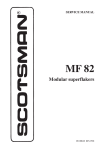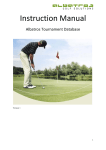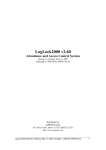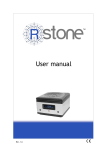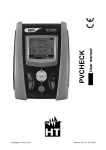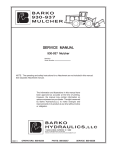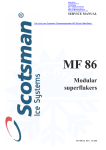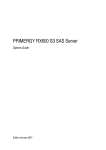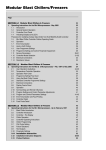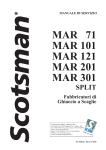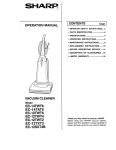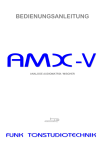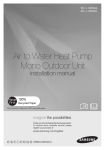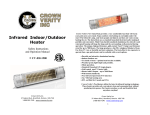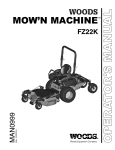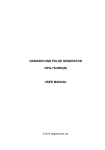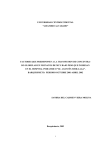Download MAR 71 - Ice Systems
Transcript
Page 1 Page 1 SERVICE MANUAL MAR 71 MAR 101 MAR 121 MAR 201 MAR 301 SPLIT SPLIT 090144.00 REV. 10/2001 Page 2 Page 2 FOREWORD SCOTSMAN MAR SPLIT UNITS are available in five basic models MAR 71, MAR 101, MAR 121, MAR 201 and MAR 301 pre set, upon request, to operate with fresh or sea water. The refrigerating and electrical system must be completed by the purchaser as per the instructions given in this service manual who has to provide for the complete condensing unit, its controls and refrigerant tubings. They come complete with a stainless steel cabinet, with a drive motor at V. 230/50/3 or 400/50/3-N Volt, with expansion valve, heat exchanger float reservoir, time delay switch, bin thermostat, water pump, ice spout switch, liquid solenoid valve, and water pressure control. We suggest to take time now to read this manual which contains a lot of valuable informations on the MAR Split System. For any further queries regarding the care or operation of the machine, please contact: ®® ICE SYSTEMS SCOTSMAN - EUROPE - FRIMONT SPA Via Puccini, 22 - 20010 Bettolino di Pogliano (Milano) Italy Tel. +39-02-93960.1 (Aut. Sel.)- Telefax +39-02-93550500 Direct Line to Service & Parts: Phone +39-0331-589305 - Fax +39-0331-584306 Website: www.scotsman-ice.com E-Mail: [email protected] Page 3 Page 3 TABLE OF CONTENTS Section I Section II Section III Foreword Table of contents Specifications GENERAL INFORMATION General Application area Condensing unit Control devices Location considerations Refrigerant lines Hydraulic circuit Ice storage room Unit layout INSTALLATION Unpacking and inspection Location and levelling Refrigerant piping connections Water piping connections Water and refrigerant circuit Electrical connections Installation practice Mar Split in multiple installation Typical non-code commercial installation page 2 3 4-9 10 10 10 11 12 12 12 12-14 15 16 16 16 17 17 18 19 20 20 TESTING Complete system leak test Complete system evacuation Complete system charging Start-up & Check-out Operational check-out 21 21 21 21 21-22 PRINCIPLE OF OPERATION - HOW IT WORKS ICE maker MAR Split electrical/refrigeration 23 24-25 ADJUSTMENT & REMOVAL & REPLACEMENT PROCEDURES MAR Split 26-27 Section VI MAINTENANCE & CLEANING INSTRUCTIONS 28-29 Section VII SERVICE DIAGNOSIS 30-31 Section VIII WIRING DIAGRAMS 32-33 Section IV Section V Page 4 Page 4 SPECIFICATIONS MAR 71 - 101 - 121 - 201 - 301 MAR 71 MAR 101 MAR 121 MAR 201 MAR 301 A 876 876 876 1297 1297 B 621 621 621 661 661 C 380 380 380 715 715 Ø1 3/4" gas 3/4" gas 3/4" gas 3/4" gas 3/4" gas Ø2 3/8" gas 3/8" gas 3/8" gas 1/2" gas 1/2" gas Ø3 3/4" gas 3/4" gas 3/4" gas 28 mm 42 mm Ø4 21 mm 21 mm 21 mm 21 mm 21 mm Ø2 = LIQUID LINE CONNECTION Ø4 = WATER OUTLET CONNECTION Ø1 = WATER INLET FITTING Ø3 = GAS LINE CONNECTION (SUCTION) TECHNICAL SPECIFICATION SPLIT MODEL Basic Electricals V MAR 71 MAR 101 MAR 121 MAR 201 MAR 301 400/50/3 - N 230/50/3 400/50/3 - N 230/50/3 400/50/3 - N 230/50/3 400/50/3 - N 230/50/3 400/50/3 - N 230/50/3 Ice Production (*) Kg/24 Hr. Sea water **** **** 850 **** 1800 Cooling req.ts Drive Motor Evap.T.°C Kcal/Hr Hp Amp 510 -18 3200 1/2 670 -24 4800 1/2 1000 -24 6000 1/2 1650 -20 8250 1/2 2200 -30 9700 1/2 1.2 2.1 1.2 2.1 1.2 2.1 1.2 2.1 1.2 2.1 Fresh W. Finish Shipping Weight kg SS 131 SS 131 SS 131 SS 223 SS 223 (*) "THICK ICE" SETTING - AT 10°/10°C (ambient/water temp.) NOTE. Under these conditions ice production is of 2 mm thickness with output temperature of about -20/-12°C. For more details please refer to production diagrams on the next pages. Condensing unit, control panel and installation are not provided by SCOTSMAN EUROPE / Frimont. Page 5 Page 5 MAR 71 SPLIT Set for Fresh water Operation ICE MAKING CAPACITY NOTE. The production diagrams herebelow represented can be used as reference, since the data indicated have been obtained with a air/water cooled condensing unit equipped with a hermetic compressor type U.H. TFH 2480Z providing - 3200 Kcal/hr at -18 °C Refrigerating capacity. AIR COOLED MODELS Kg./24 h 520 o°C 10 480 AMBIENT TEMPERATURE ICE PRODUCED PER 24 HRS. 500 21 460 440 420 32 400 38 380 360 340 32 27 21 15 10 °C WATER TEMPERATURE Thicker scale ice IMPORTANT OPERATING REQUIREMENTS: WATER LEVEL IN DRUM RESERVOIR WITH WATER PUMP / SPRAY BAR 115-120 mm DRUM ROTATING SPEED 1.1 RPM (thick ice) CONDENSING CAPACITY 4900 Kcal/hr (TD 10 ÷ 15 °C) HEAD PRESSURE SETTING 15 ÷ 17 Bar on air cooled units 17 Bar on water cooled unit LOW PRESSURE SETTING 2.2 Bar on air cooled units 1.8 Bar on water cooled units HI-PRESSURE CONTROL SETTING 34 ± 2 Bar A/C 30 ± 2 Bar W/C LO-PRESSURE CONTROL SETTING 0.2 Bar WATER PRESSURE CONTROL SETTING 0.8 Bar MAX. WATER TEMPERATURE 35 °C MIN. WATER TEMPERATURE 5 °C MIN. WATER PRESSURE 1 atm. MAX. WATER PRESSURE 5 atm. MIN. AMBIENT TEMPERATURE 5 °C MAX. AMBIENT TEMPERATURE 40 °C MAX. VOLTAGE VARIATION ± 10% Page 6 Page 6 MAR 101 SPLIT Set for Fresh water Operation ICE MAKING CAPACITY NOTE. The production diagrams herebelow represented can be used as reference, since the data indicated have been obtained with a air/water cooled condensing unit equipped with a hermetic compressor type U.H. TAG 2516Z providing - 4800 Kcal/hr at -24 °C Refrigerating capacity. Kg./24 h 750 o°C 700 10 650 21 AMBIENT TEMPERATURE ICE PRODUCED PER 24 HRS. AIR COOLED MODELS 32 600 38 550 500 450 32 27 21 15 10 °C WATER TEMPERATURE Thicker scale ice IMPORTANT OPERATING REQUIREMENTS: WATER LEVEL IN DRUM RESERVOIR WITH WATER PUMP / SPRAY BAR 115-120 mm DRUM ROTATING SPEED 1.5 RPM (thick ice) 2.3 RPM (thin ice) CONDENSING CAPACITY 7500 Kcal/hr (TD 10 ÷ 15 °C) HEAD PRESSURE SETTING 15 Bar on air cooled units 15 Bar on water cooled unit LOW PRESSURE SETTING 1.6 Bar on air cooled units HI-PRESSURE CONTROL SETTING 36 Bar LO-PRESSURE CONTROL SETTING 0.2 Bar WATER PRESSURE CONTROL SETTING 0.8 Bar MAX. WATER TEMPERATURE 35 °C MIN. WATER TEMPERATURE 5 °C MIN. WATER PRESSURE 1 atm. MAX. WATER PRESSURE 5 atm. MIN. AMBIENT TEMPERATURE 5 °C MAX. AMBIENT TEMPERATURE 40 °C MAX. VOLTAGE VARIATION ± 10% Page 7 Page 7 MAR 121 SPLIT Set for Fresh water Operation ICE MAKING CAPACITY NOTE. The production diagrams herebelow represented can be used as reference, since the data indicated have been obtained with a air/water cooled condensing unit equipped with a hermetic compressor type U.H. TAG 2522Z providing - 6000 Kcal/hr at -24°C Refrigerating capacity. AIR COOLED UNITS 10 1000 21 900 850 32 800 750 38 700 AMBIENT TEMPERATURE ICE PRODUCED PER 24 HRS. 950 650 600 38 32 27 21 15 10 5 °C WATER TEMPERATURE Thicker scale ice IMPORTANT OPERATING REQUIREMENTS: WATER LEVEL IN DRUM RESERVOIR WITH WATER PUMP / SPRAY BAR 115-120 mm DRUM ROTATING SPEED 2.4 RPM (thick ice) CONDENSING CAPACITY 9750 Kcal/hr (TD 10 ÷ 15 °C) HEAD PRESSURE SETTING 14 ÷ 16 Bar on air cooled units LOW PRESSURE SETTING 1.6 Bar on air cooled units HI-PRESSURE CONTROL SETTING 36 Bar LO-PRESSURE CONTROL SETTING 0.2 Bar WATER PRESSURE CONTROL SETTING 0.8 Bar MAX. WATER TEMPERATURE 35 °C MIN. WATER TEMPERATURE 5 °C MIN. WATER PRESSURE 1 atm. MAX. WATER PRESSURE 5 atm. MIN. AMBIENT TEMPERATURE 5 °C MAX. AMBIENT TEMPERATURE 40 °C MAX. VOLTAGE VARIATION ± 10% Page 8 Page 8 MAR 201 SPLIT Set for Fresh water Operation ICE MAKING CAPACITY NOTE. The production diagrams herebelow represented can be used as reference, since the data indicated have been obtained with a air/water cooled condensing unit equipped with a hermetic compressor type DORIN K500 CS providing - 8250 Kcal/hr at -20 °C Refrigerating capacity. Kg. 1900 38 32 1500 38 1400 1300 1200 1100 1800 1700 1600 1500 1400 1300 38 32 27 21 15 10 5 °C 38 WATER TEMPERATURE 32 27 21 15 10 WATER TEMPERATURE Thiner scale ice Thicker scale ice IMPORTANT OPERATING REQUIREMENTS: WATER LEVEL IN DRUM RESERVOIR WITH WATER PUMP / SPRAY BAR 90-95 mm DRUM ROTATING SPEED 1.05 RPM (thick ice) 1.60 RPM (thin ice) CONDENSING CAPACITY 11000 Kcal/hr (TD 10 ÷ 15 °C) HEAD PRESSURE SETTING 16 ÷ 18 Bar on air cooled units 16 ÷ 17 Bar on water cooled unit LOW PRESSURE SETTING 1.9 Bar HI-PRESSURE CONTROL SETTING 36 Bar LO-PRESSURE CONTROL SETTING 0.2 Bar WATER PRESSURE CONTROL SETTING 0.8 Bar MAX. WATER TEMPERATURE 35 °C MIN. WATER TEMPERATURE 5 °C MIN. WATER PRESSURE 1 atm. MAX. WATER PRESSURE 5 atm. MIN. AMBIENT TEMPERATURE 5 °C MAX. AMBIENT TEMPERATURE 40 °C MAX. VOLTAGE VARIATION ± 10% 5 °C AMBIENT TEMPERATURE 32 21 o°C DE 10 A' 38 ICE PRODUCED PER 24 HRS. 10 1600 ICE PRODUCED PER 24 HRS. Kg. 1700 WATER COOLED UNITS °C 10 21 AMBIENT TEMPERATURE AIR COOLED UNITS Page 9 Page 9 MAR 301 SPLIT Set for Fresh water Operation ICE MAKING CAPACITY NOTE. The production diagrams herebelow represented can be used as reference, since the data indicated have been obtained with a air/water cooled condensing unit equipped with a semihermetic compressor type DORIN K1000 CS providing - 9700 Kcal/hr at -30 °C Refrigerating capacity. WATER COOLED UNITS °C Kg. 2800 2200 32 10 2000 21 1800 32 38 38 1600 1400 o°C 2600 DE 10 A' 38 21 ICE PRODUCED PER 24 HRS. 10 2400 AMBIENT TEMPERATURE ICE PRODUCED PER 24 HRS. Kg. 2600 2400 2200 2000 1800 1600 38 32 27 21 15 10 5 °C 38 WATER TEMPERATURE 32 27 21 15 10 5 WATER TEMPERATURE Thiner scale ice Thicker scale ice IMPORTANT OPERATING REQUIREMENTS: WATER LEVEL IN DRUM RESERVOIR WITH WATER PUMP / SPRAY BAR 90 mm DRUM ROTATING SPEED 1.6 RPM (thick ice - air cooled) 1.8 RPM (thick ice - water cooled) 2.9 RPM (thin ice) CONDENSING CAPACITY 16200 Kcal/hr (TD 10 ÷ 15 °C) HEAD PRESSURE SETTING 15 Bar on air cooled units 14 Bar on water cooled unit LOW PRESSURE SETTING 1 Bar on air cooled units 0.75 Bar on water cooled unit HI-PRESSURE CONTROL SETTING 34 ± 2 A/C Bar 30 ± 2 W/C Bar LO-PRESSURE CONTROL SETTING 0.2 Bar WATER PRESSURE CONTROL SETTING 0.8 Bar MAX. WATER TEMPERATURE 35 °C MIN. WATER TEMPERATURE 5 °C MIN. WATER PRESSURE 1 atm. MAX. WATER PRESSURE 5 atm. MIN. AMBIENT TEMPERATURE 5 °C MAX. AMBIENT TEMPERATURE 40 °C MAX. VOLTAGE VARIATION ± 10% °C AMBIENT TEMPERATURE AIR COOLED UNITS Page 10 Page 10 SECTION I GENERAL INFORMATION GENERAL The MAR SPLIT UNITS are pratically the "Evaporating Unit Section" complete with driving mechanism and control devices, all encased in their stainless steel cabinets, for making complete scale-ice maker system The MAR SPLIT UNITS must be remotely connected to a corresponding size "Condensing Unit" to become a MAR scale-ice maker plant, it is therefore of primary importance first, the selection of the right type and size of all the components to be used to complete the refrigerant system and secondly - but not least - the skillness of the refrigeration engineers that will proceed in completing the system by making the refrigerant, hydraulic and electrical connections. APPLICATION AREA The scale-ice maker system using the MAR Split Units, applies to different sort of market situations where scale-ice is needed. Most specific areas are: a) Fishing Vessels b) Fish Markets and Fish Processing Plants c) Supermarkets d) Meat packaging plants Basically they can go in any place where there is a limited space situation or where the condensing unit (compressor/condenser) must be located in a room where noise and heat is not objectionable. MAR Split can be set to produce "THICK ICE" generally used in the fishing industry or "THIN ICE" generally used in the meat processing industry. Standard versions are set for "THICK ICE" production (about 2 mm thickness) and for fresh water operation. Different conditions should be specified when ordering the Units. Modular combinations are possible to increase output ice production. COMPLETE SYSTEM INSTALLATION - How it is made The complete scale-ice making system can be divided in three major groups, that are: a) the compressor and condenser unit with their own components with their own refrigerant and water lines fittings and electric wires terminal block. b) the evaporator drum unit (MAR Split Unit supplied by Frimont) complete with drive mechanism, drive motor, refrigerant and water lines fittings, refrigerants expansion valve and electric wire junction box. c) console panel and control box with compressor ON/OFF switch, relay, timer, warning lights, pressure gauges and electrical wire terminal block. For installation on board of fishing vessels where the electrical power available is not sufficient or adequate to run the compressor, a mechanical or hydraulic drive transmission must be used. These drive systems will not be covered in details in this manual as it is assumed that their fundamentals have been already mastered to the installator engineer by more specific publications. CONDENSING UNIT The compressor is truly the heart of the system, when it becomes inoperative refrigeration immediately ceases. Therefore the selection of proper type and size of compressor together with the proper type and size of condenser, their components and controls, deserve the most of attention by the refrigeration engineer. For our MAR ice making system, the compressor to take is consideration are ot two basic types: a) the accessible Semi-Hermetic-MotorCompressor for installation on sites where the electrical power supply is available in adequate quantity and quality. b) the Open Type Compressor for automative installations (Fishing Vessels) with mechanical pneumatic or hydraulic drive system through a magnetic clutch. Whatever is the type of compressor being used, it is recommended, for its selection, to observe the refrigerant capacity on the following table: MAR 71 3200 Kcal/h -18°C Evap. Temp. MAR 101 4800 Kcal/h -24°C Evap. Temp. MAR 121 6000 Kcal/h -24°C Evap. Temp. MAR 201 8250 Kcal/h -20°C Evap. Temp. MAR 301 9700 Kcal/h -30°C Evap. Temp. Page 11 Page 11 The condenser is basically a heat exchanger where the heat absorded by the refrigerant during the evaporating process is given to the condensing medium which could be the air or the water. The approximate heat transfer capacity for the condenser selection is shown on the herebelow table MAR 71 MAR 101 MAR 121 MAR 201 MAR 301 4900 Kcal/h 7500 Kcal/h 9750 Kcal/h 11000 Kcal/h 16200 Kcal/h Particular care must be deserved to the selection of the water cooled condenser expecially the marine type for fishing vessels installation. They can be marine type (cupro-nickel) tube within a tube condenser with plasticized heads. With water inlet temperature of +20°C and outlet of +30°C at condensing temperature of 32°C the water consumption should be: MAR 71 MAR 101 MAR 121 MAR 201 MAR 301 300 lt/hr 450 lt/hr 84*****h 1200 lt/hr 1600 lt/hr When using marine type condenser a marine type, water regulating valve is requested as well to modulate the cooling water flow within condenser. Recommendend valve is the pressure actuated "PENN". The Liquid receiver is a storage tank for liquid refrigerant that can be useful on refrigeration split installation to make the quantity of refrigerant in the system less critical. It is normally provided with two service valves and occasionally can be built-in the bottom of condenser. It is a common component used in refrigeration plant and should be large enough to hold all the refrigerant in the system. The Oil separator should be filled with oil during installation until the float valve just begins to open. This oil quantity always remains in the separator and would otherwise be taken from the compressor. It is well known that when the compressor operates, small amount of oil is pumped out along with the hot compressed vapor and to prevent it from going any further in the system, the oil separator traps it to return, upon opening of its float valve, to the crankcase of the compressor. CONTROL DEVICES The scale-ice maker system must be completed with all the necessary safety devices and controls in order to fully protect it and to minimize operational checks and functions, however any excess in using automatic controls and protections may complicate the situation at the point that some of the controls be eliminated later, by the user. In order to help the installator engineer to decide with which controls he has to equip a given system, we cover all the necessary ones mentioning for each of them the positive factors and eventually the negative ones. High Pressure Control Very important - No negative factors Set to values shown on techn. spech. Not supplied. Water Pressure Control Very important - No negative factors Set to 0.8 atm-cut-in - 0.5 atm cut-out. Supplied. Lo Pressure Control Very important because in case of refrigerant leaks at the evaporator, it prevents to draw in the system some water from the drum reservoir. It also prevents to draw air through the compressor crank-shaft seal. This may occure during vacuum operations of the system. However, it may inopportunely trip-off at the system start-up and if suction operating pressure, on account of the excessive rotating speed of compressor or excessive compressor capacity, is very close and gets below its setting value, which is 0.2 atm. Not supplied. Page 12 Page 12 LOCATION CONSIDERATION WARNING - The MAR SCALE ICE MAKERS are not designed for outdoors installations where air temperature falls below 5°C (40°F) and may exceed 40°C (100°F) Operating a machine with an unacceptable configuration will void the refrigeration system warranty. For installation on board of fishing vessels, the location for the condensing unit is generally the engine room, while the evaporator unit can be permanently placed in some area of the deckhouse or if it is not too cold (not below 5°C), inside the fish and ice hold. In case a stand is going to be made and used plan for adequately fastening the MAR SPLIT UNIT. The stand must be steady made to do not cause excessive vibrations and must have the possibility to be securely fastened to the wall or to the floor. In relation to evaporator position and situation a certain kind of ice chute is required. Make sure to have it available for the start-up of the system. REFRIGERANT LINES Inner diameter of refrigerant lines going from condensing unit to evaporator unit and back, must be of adequate size in relation to tubing lenght. The table below show the recommended sizes of refrigerant lines: MODELL Lenght of tubes MAR 71 MAR 101 MAR 121 MAR 201 MAR 301 5 to 15 mt 5 to 15 mt 5 to 15 mt 5 to 15 mt 5 to 15 mt Suction line Liquid line 18 mm 18 mm 18 mm 28 mm 42 mm 12 mm 12 mm 12 mm 12 mm 12 mm 2. Insulate lines that will be exposed to outside temperature that will be below freezing for extended period of time. 3. Follow straight line routing, when possible, however give to the suction line a certain pitch (2 cm per meter). On liquid line be sure to do not have restrictions. Bends and fittings should be the minimum necessary as they can increase the resistance to the fluid flow. 4. To prevent any condensing unit vibration travelling into the lines, vibration absirbers may be installed in the suction and the liquid lines near the condensing unit. Because the appearence of an installation is important, the piping should be put-in as neathly as possible. For best sound absorb-tion, it is best to put-in two absorbers in each line, one vertically and one horizontally. For evacuation and charging operations two service valves must be provided. One on the liquid line and one on the suction line. 5. A drier and a sight glass should be installed in the liquid line at the condensing unit. HYDRAULIC CIRCUIT Another item that requires a preliminarly attenzion for the MAR SPLIT installation is the water supply to the ice making section and to the condensing unit case a water cooled condenser is being used. Separate water linea are recommended with hand shut-off valve and water filter on individual line. Remember: – Maximum Water Temperature – Minimum Water Temperature – Minimum Water Pressure – Maximum Water Pressure 35°C 5°C 1 atm 5 atm The Ice Making Section (MAR SPLIT UNIT) generally requires: – 21 lt/hr – 29 lt/hr – 42 lt/hr – 70 lt/hr – 91 lt/hr MAR 71 MAR 101 MAR 121 MAR 201 MAR 301 of constant water supply. The water consumption of the water cooled condenser (in case of water cooled condensing unit) to be taken on account, with water inlet temperature at 15°C is: – 300 lt/hr – 480 lt/hr – 1200 lt/hr – 1500 lt/hr – 1600 lt/hr MAR 71 MAR 101 MAR 121 MAR 201 MAR 301 For installation on fishing vessels, using seawater, to carry sea water from sea chest to the condensing unit and to evaporating unit through appropriate strainers, you may use aluminium brass pipes or PHE plastic pipes to avoid corrosion problems. Never use copper tubes. ICE STORAGE ROOM Ice storage situations are of two kinds: a) Short terms storage b) Extended terms storage Being, as stated scale ice made by MAR machines flat, dry and subcooled, therefore with the tendency to stick toghether, particular attention is required for proper ice storage conditions for better ice handling. An insulated ice storage bin or room is always required, then according to ice end use application, this can be refrigerated or non-refrigerated. Page 13 Page 13 Also a weight volume ratio of 2.1 cm. mt. per ton, must be taken into consideration for correct ice storage. is being used on a daily basis, it is not necessary to provide cooling for the ice storage room. a) Non-refrigerated room for short term storage The scale ice is produced continuously for 24 Hours per day, whereas the use period is generally for no longer than 8 hours per day. Therefore storage facilities should be provided to accomodate a minimum of 16 hours of production, this means that every MAR ice machine must be installed with a properly insulated storage room which should have a minimum capacity of 2/3 the daily ice production. With a well insulated room and duly subcooled scale ice, the limited losses of heat through the walls of a properly designed room with adequate arrangements, are largely offset, and excess melting will not occur. In most situations where whole quantity of ice produced b) Refrigerated room for extended storage and long distance conveying When scale ice is to be transported at a considerable distance, such as aboard fishing vessels, or in locations with normal ambient temperatures conditions, or when used in industrial plants where demand is intermittent, its subcooling power must be preserved absolutely in the storage bin by a proper cooling system keeping air temperature at a pre-established and constant value. The ideal ice storage room is the type with mechanically refrigerated jacket space surrounding the ice bin. Good practice calls for an ice storage capacity of about two times the daily ice machines production with an inside temperature of -6°C minimum (20°F). Page 14 Page 14 NON REFRIGERATED ICE STORAGE ROOM REFRIGERATED ICE STORAGE ROOM (Jacket system) 1 2 3 4 5 6 7 8 9 10 11 12 13 14 15 Condensing unit Liquid line Evaporator drum unit Suction line Power supply line Hand disconnect switch Water supply line Hand shut-off valve Water filter Condenser water inlet Condenser water outlet Evaporator water supply Water drain line Liquid line service valve Suction line service valve 1 2 3 4 5 6 7 8 9 10 11 12 13 Condensing unit Liquid line Evaporator drum unit Suction line Power supply line Hand disconnect switch Water supply line Hand shut-off valve Water filter Condenser water inlet Condenser water outlet Evaporator water supply Water drain line 14 15 16 17 Refrigerant coil Insulated panel Air gap Ice bulkhead Page 15 Page 15 WATER INLET R404 LIQUID R404 GAS WATER OUTLET UNIT LAYOUT AND OVERALL DIMENSIONS DENOMIN. MAR SPLIT 71-101-121 MAR SPLIT 201-301 A 278 (10 15/16) 278 (10 15/16) B 621 (24 13/32) 661 (26 1/32) C 876 (34 31/64) 1296 (51 1/32) D 380 (14 61/64) 715 (28 5/32) E 248 290 (11 7/16) (9 3/4) Page 16 Page 16 SECTION II INSTALLATION MAR SPLIT UNIT - UNPACKING AND INSPECTION 1. Visually inspect the exterior of the shipping container and skid and any severe demage noted should be reported to the delivery carrier; and a concealed damage claim filled subject to internal inspection with carrier representative present. 2. Remove the packing and remove the side panels to unloose the shipping bolts securing the unit to the skid. 3. Remove screw and all panels from cabinet and inspect for any concealed damage. Notify carrier of any concealed damage claims as stated in step 1 above. 4. Remove all internal packing from unit compartment. 5. Check that refrigerant lines do not rub or touch lines or surfaces and that all wires are securely fastened to their terminals. 6. Use clean damp cloth or disposable paper wiper to wipe clean the exterior surface of the cabinet. 7. See DATA PLATE on the cabinet base and check that the location source voltage corresponds with the voltage specified on the dataplate. CAUTION - Unproper voltage supplied to the icemaker will void your parts replacement programm. MAR SPLIT UNIT - LOCATION AND LEVELLING 1. Position the MAR SPLIT UNIT in the selected permanent location which could be on top of ice storage cabinets, on the side of cold storage room supported by special pre-set stands or, in case of fishing vessel installation, inside or on top of the fish hold. 2. After having placed the unit on the support stand, level the cabinet on both the left to righ and front to rear directions, by inserting between the unit base and a support stand few rubber pads. Fit in unit base holes in the cabinet, appropriate bolts to fasten unit to stand. Make sure to leave enough space around the unit to allow access to internal components for inspection and servicing and also for the fitting of the ice chute if needed. 3. Proceed to position the condensing unit in its location and to mount it firmly to avoid a sudden shift that would endager the refrigerant lines. Precautions to be observed vary with the kind of situation in which the unit is to be placed. The area should be well ventilated to permit escape of refrigerants in case unit develops a leak. MAR SPLIT UNIT - REFRIGERANT PIPING CONNECTION Fitting sizes: MAR 71-101-121 MAR 201 MAR 301 Liquid Line Suction Line 3/8" Gas 1/2" Gas 1/2" Gas 3/4" Gas Ø 28 mm Ø 42 mm Take extreme care to keep refrigeration tubing clean and dry prior to installation. Following procedure should be followed: a) Do not leave dehydrated compressor or filterdrier open to the atmosphere any longer than it is absolutely necessary. (One or two minutes maximum suggested). b) Use only refrigeration grade copper-tubing, properly sealed against contamination. c) Permanent suction lines filters and liquid line filter-driers are recommended in all filled installed system. d) When brazing refrigerant lines, an inert gas should be passed through the line at low pressure to prevent scaling and oxidation inside the tubing. Dry nitrogen is preferred. e) Line connection to vibration eliminators be made with silver solder alloy. Arrange that refrigerant lines run along the walls and cellings and be supported at intervals frequent enough to keep tubing atraight and firmly in place. In all cases the tubing should be run horizontally and vertically with neat looking bends of as perfect radius as possible. The liquid line presents no difficulties as to its sland and position, but you must install the suction line so the tubing will drain toward the compressor. During preparation of liquid line take the necessary measure to install after evacuation of system, the filter-drier of suitable size for constant operation. You may as well consider to install on suction line a suction tube filter, specially if the required cleaness cannot be guaranteed. After all lines are connected, the entire system must be leak tested. The complete system should be pressurized to no-more than 12-13 atm. with refrigerant and dry nitrogen or dry CO2 for being leak tested by means of an electronic type leak detector. Page 17 Page 17 For pressurizing, evacuating and charging the system, two service valves are necessary; one should be in the Suction Line at the inlet side of suction filter and one should be in the Liquid Line at the outlet side of filter dryer. The two Service Valves, if properly capped can be left permanently in the system. Connection should be 3/8" or 1/2" size. MAR SPLIT UNIT - WATER PIPING CONNECTIONS (PLUMBINGS) MAR SPLIT UNIT is supplied with float valve in position to maintain the water level in drum reservoir at the height required for fresh water operation or if required, for sea water operation. Water inlet line must go directly to float valve line fitting of 3/4" gas, (copper tube is not recommended for sea water supply) also make sure to fit on this same a hand shut-off valve close enough to MAR unit and a proper kind and size of filter strainer. Incoming water geoes through the float reservoir first and then to drum basin. Outlet water line should be shaped adequately to drain by gravity any water passing through it. Water outlet fitting from float reservoir requires a 20 m/m I.D. water hose. All plumbing connections should be made in accordance with local plumbing codes. WATER AND REFRIGERANT CIRCUIT - SPLIT UNITS 1. 2. 3. 4. 5. 6. 7. Liquid line Heat exchanger Automatic expansion valve Suction line Water inlet Float valve Water basin 8. 9. 10. 11. 12. 13. Evaporation drum Scraping blade Water pump Spray bar Water tube - Pump / spray bar Liquid line valve Page 18 MAR SPLIT UNIT - ELECTRICAL CONNECTION The supply power, voltage frequency and phase must coincide with unit nameplate. MAR Split units are internally wired and ready for field wiring connections which must be made in accordance with any local codes that may apply. Wires should be of adequate size to handle the connected load, individually fused (see specifications at page 5) and provided with ground line. The maximum allowable voltage variation, should not exceed ten percent of the nameplate rating, even under starting conditions. Low voltages can cause erratic operation and may be responsible for serious damages to the overload switch and motor windings. Make the necessary steps so that the MAR Split Page 18 Unit be electrically connected to the condensing unit control box contactor as illustrated on the following wiring diagrams representing three different electric supply line situation which are respectively. 230/50/3 or 400/50/3-N. WARNING - Correct Drum rotation - The evaporator drum drive motor being a threephase motor wired for 380 V. It is of estreme importance to check immediately upon unit start-up that motor rotates CLOCKWISE in order that gear motor pulley rotates in the direction of the ARROW on it indicated. Should the motor turn counterclockwise, it is necessary to instantly switch-off the unit and interchange one polarity at terminal block connection at main electric cord. Page 19 Page 19 INSTALLATION PRACTICE SPLIT UNIT ASHORE INSTALLATION PRACTICE SPLIT UNIT ON OFFSHORE FISHING VESSEL 1 2 3 4 5 6 7 8 9 10 11 12 13 1 2 3 4 5 6 7 8 9 Condensing unit Liquid line Evaporator drum unit Suction line Power supply line Hand disconnect switch Water supply line Hand shut-off valve Water filter Condenser water inlet Condenser water outlet Evaporator water supply Water drain line Deck house Control panel & main switch Ice chute Evaporator drum unit Ice hold Fishing room Réfrigérant lines Condensing unit Engine room Page 20 Page 20 MAR SPLIT IN MULTIPLE INSTALLATION In multiple installation various types of commercial refrigerating equipment are connected to the same condensing unit, which is normally located in the machine room, as often occurs in supermarkets. MAR SPLIT can be one of the refrigerant units connected to a multiple use condensing unit. In this kind of installation it will be best to replace the standard AEV refrigerant control with a corresponding size AMXV control, which, in relation to the multiple installation situations (great evaporating temperature difference) could be of two temperature type. Also a manifold with hand shut-off valves on both liquid and suction line is recommended for these installations. In many multiple installations check valves are put in the suction line of the coldest evaporator to prevent that warmer higher pressure low-side vapor moves into colder evaporator during the off periods. Also a pressure control valve should be installed MAR SPLIT ICE MAKER on MAR SPLIT suction line to maintain constant pressure on evaporator drum. Therefore, for the MAR SPLIT multiple installation you may need: 1. Automatic Expansion valve The automatic expansion valve is the leading multiple evaporator system refrigerant control as it does not regulate the low side pressure, but, rather control the filling of the evaporator with refrigerant, it is important to use a valve for the correct capacity. 2. Solenoid valve Two-ways type to be connected in series with any MAR SPLIT protecting and starting device. 3. Pressure Control valve To be placed on the MAR SPLIT suction line. It will mantain constant pressure on MAR SPLIT evaporator drum. 4. Manifold with hand shut-off valve One to be placed on the liquid line and the other on suction line to isolate MAR SPLIT unit when necessary. TYPICAL NON-CODE COMMERCIAL INSTALLATION 4. Suction line shutoff valves 5. Liquid line shutoff valves 1. Power line 2. Main switch 3. Relay / Starter MEET ROOM DISPLAY CASE CONDENSING UNIT Installation of MAR SPLIT in multiple system should be done in the following order. 1. Put MAR SPLIT unit in place. See Sec. II Location & Levelling. 2. Install valves and controls. 3. Install tubings. See Sec. II Refrigerant piping connections. 4. Make water piping connections. See Sec. II Plumbing. 5. Make electrical connections See Sec. II Electrical connections. 6. Check for leaks. See Sec. II Leak Test. 7. Dehydrate installation. See Sec. III Evacuation / Charging. 8. Start unit. See Sec. III Operazional Check-out. Page 21 Page 21 SECTION III TESTING COMPLETE SYSTEM LEAK TESTS During pressure testing for leaks, keep the compressor suction service valve and discharge service valve closed to prevent air and moisture from entering the compressor. All other valves in the system must be open. Sufficient liquid refrigerant shall be charged into the system to raise the pressure to 2.5 atm. and dry nitrogen added to obtain the desired test pressure (20.5 atm is sufficient). Leak testing shall be performed with an electronic leak detector, unless the use of a halide torch is specifically authorized by the owner. Refrigeration piping will not be acceptable unless it is gas tight. If any leaks are found, isolate the defective area, discharge the gas and repair the leaks and then repeat the test. When testing has been completed release all pressure freely to atmosphere. COMPLETE SYSTEM EVACUATION The system shall be evacuated with a vacuum pump specifically manufactured for vacuum duty, having a capacity of pulling a vacuum of 50 microns or less. Evacuation of the system must never be done by the use of the refrigerant compressor. The pump should be connected to both the low and high side evacuation valves with vacuum hoses. The compressor service valves should remain closed. A high vacuum gauge capable of registering pressure in microns should be attached to the system pressure readings. Never put the compressor in operation. To check system pressure, a hand valve must be provided between the pressure gauge and the vacuum pump which can be closed to isolate the system and check the pressure. Evacuate the system to an absolute pressure not exceeding 1,500 microns. Creak the vacuum to excess pressure of 0,15 atm (1 psig) with the refrigerant to be used in the system. Repeat the evacuation process again breaking the vacuum with refrigerant. Install a definitive drier of the required size in the liquid, open the compressor suction and discharge valves and evacuate to an absolute pressure not exceeding 500 microns. Leave the vacuum pump running for not less than two hours without interruption. Raise the system pressure to 0,15 atm (1 psig) with refrigerant and remove the vacuum pump. Wheigh the refrigerant drum before charging so that an accurate record can be kept of the weight of refrigerant put in the system. It refrigerant is added to the system through the suction side on the compressor, charge in vapor form only. The process used most often to determine correct refrigerant charge is to observe the refrigerant flow in the sight glass in the liquid line. As steady supply of liquid is necessary for proper functioning of expansion valves; it can be assumed that the system has been correctly charged when a clear flow of liquid refrigerant is visible. Bubbles or foam usually indicate insufficient refrigerant, even if there could be other reason for the bubbles or foam to appear in the sight glass. So, the practice to relay on the sight glass only to determine whether the systems is correctly charged is certainly good but not fully positive. After the final leak test, refrigerant lines exposed high ambient conditions should be insulated to reduce heat pick-up and prevent the formation of flash gas in the liquid lines. Suction line should be insulated if exposed, to prevent condensation. START-UP - CHECK-OUT Compressor and condensing unit will normally be delivered to the job with sufficient oil for average installation. Check compressor for proper oil level and, if necessary, add sufficient oil to bring the level to the center of the cranckase sight glass. Use only refrigeration oil recommended by the compressor manufacturer. Remove or loosen shipping retainers under motor-compressor. Make sure hold down nuts on spring mounted compressor are not touching the compressor feet. Check electrical connections. Be sure they are all tight. Check high and low pressure control, water valves, pressure regulating valves, safety controls and adjust if necessary. OPERATION CHECK-OUT After system has been charged and checked-out make sure to correctly position, attached to the unit ice spout, the require chute (not supplied). COMPLETE SYSTEM - CHARGING Perform a through re-check of entire system as per following steps. Refrigerant shall be charged directly from original drums through a combination filter drier. Charge the system by means of a charging fitting in the liquid line. 1. Make sure to open the water supply line shutoff valve and that water flows freely from float valve into float reservoir and from this to the drum basin. Page 22 Page 22 2. Put power to the system in order to start-up the evaporator drive motor, the water pump and the compressor. 3. Observe that evaporator drum rotates in the right direction, namely towards the scraping blade. WARNING - Drum drive motor is threephase, at the unit startup, care must be taken to ensure of the correct rotation direction of drum. In case of wrong rotation interchange the phases by interchanging the lead wire connections of main cord. 4. Check compressor head and suction pressures. If not within system design limits, determine why and take corrective action. 5. For water cooled condensing unit check the water flowing out of the condenser to see if it drains properly. 6. Observe if ice skin tends to cover entire drum surface and is being scraped-off correctly by the blade. 7. Check liquid line sight glass and expansion valve operation. If there are indications that more refrigerant is required leak test all connections before adding refrigerant. 8. Observe oil level in compressor crankcase sight glass and add oil as necessary to bring level to center of the sight glass. 9. Let the system operate for at least two hours, then check one by one the operation of each individual control and protective device for proper setting. 10. Eliminate any excessive vibration or noise and pulleys misalignement. 11. Observe that evaporator drum is frosted all over from end to end. If this is not the case setting of refrigerant expansion valve may be necessary. For proper adjustement of this valve turn the valve setting stem of one eight of a turn counter-clockwise to allow more refrigerant to flow until the evaporator drum surface is evenly frosted from end to end. In case there is an excessive frost back on the suction line and frost start to form on compressor suction service valve, slightly turn clockwise the expansion valve setting stem until the frost back on the compressor service valve melts over. Indicative Operating Pressure - With Fresh Water Supply - Water Cooled System Head Pressure (bar) Suction Drum R.P.M. (thick ice) MAR 71 17 1.8 1.1 MAR 101 15 1.6 1.5 MAR 121 15 1.6 2.4 MAR 201 15 1.6 1.05 MAR 301 14 0.75 1.8 Indicative Operating Pressure - With Sea Water Supply - Water Cooled System MAR 121 Head Pressure (bar) Suction Drum R.P.M. (thick ice) 1.52 MAR 301 1.82 12. In relation to the desired quality of scale ice, review the position of float reservoir to see if water in drum reservoir is at the corresponding level. Water level must not exceed in any case the following limits: MAR 71 - MAR 101 - MAR 121 MAR 201 - MAR 301 115-120 mm 90-95 mm 13. Observe that ice slides through spout opening with no difficulties. Clearence between the blade and drum surface must be 0,10 m/m. Transparent plastic chute must be flat. 14. When the system is performing satisfactorily go over with the owner/user to all significant specifications, the start-up and operations. Answer alla questions about the care and attention to give to the ice making system. Page 23 Page 23 SECTION IV PRINCIPLES OF OPERATIONS - HOW IT WORKS 1. ICE MAKER The revolving drum which may be of two different sizes depending on the ice maker capacity, is basically made of a cylinder skeleton covered by a stainless steel jacket. There is a channel, about 15 m/m deep and 15 m/m wide on the surface of the cylinder skeleton which, in a spiral pattern, goes from one end to the other of cylinder. Both the ends of the channel communicate with a bore made in the left cylinder journal. The head manifold on the left side is for either liquid refrigerant inlet and vapor refrigerant outlet. When a cylinder stainless steel jacket is forced and sealed on the drum, the spiral pattern channel made for the refrigerant flow becomes virtually the evaporator serpentine. The metered refrigerant that reaches the evaporator serpentine by passing throught the head manifold in the left side cylinder journal, boils and evaporatores as it comes into contact with the drum metal jacket. About one third of the cylinder drum is constantly submerged in water this will allow the cylinder metal jacket to draw a film of water that, as soon as it comes afloat, freezes almost instantly due to the heat absorption created by the boiling refrigerant circulating in the inner serpentine and scrubbing with the jacket inner surface. On fresh water installation a combination of water pump and water distributor tube provides a constant flow of cold water to the upper side of the evaporator drum so to have an extended metal jacket surface covered by water and a thicker ice layer. Then the ice layer of the emerged cylinder sector has a fraction of time to solidify, dry and eventually subcool before contacting the edge of the horizontal scraping blade. The scraping blade, of heavy duty metal, cause the peel off of the ice sheet formed on the drum jacket by racking it while it advances on the revolving drum. The ice sheet is so dry that, when it gets in contact with the scraping blade, it cracks in a form of irregular shaped chips. The refrigerant leaves the evaporator serpentine to return to the compressor via suction line through the inner bore of the left side cylinder journal. The refrigerant sealing in inlet/outlet head manifold is assured by specially designed sealing device, the cylinder is driven by separate drive motor and gear reducer located on the right basin frame. The gear reducer, the driving belt with its pulley, the revolving drum with the rotating part of the sealing devices and the water pump on fresh water installation are the mechanical parts in motion. 2. PRINCIPLES OF OPERATION - HOW IT WORKS 1. 2. 3. 4. 5. 6. 7. 8. 9. 10. Water drawing area Water sprayed freezing cooling area Sub-cooling area Float valve Water feeding line Scraping blade Water pump Water basin Revolving drum Water distributor tube Page 24 Page 24 3. MAR SPLIT - ELECTRICAL / REFRIGERATION The electrical circuit consists of drive motor, water pump, water pressure switch, spout switch and time delay safety device. A. Drive motor The evaporator drum drive motor is a three phase motor of 1/2 HP wired for 380/220 Volts 50/60 Hz - 1,2/2,1 Amps - 1400 R.P.M. with inherent thermal protector. IMPORTANT - When this motor is disconnected or the entire unit is disconnected, it is necessary - when resuming the electrical connection to immediately make sure that drive motor rotates clockwise facing the unit front. Failure to this, may result in wrong rotation of evaporator drum with the risk of major damages to the system. B. Water failure Switch This switch used as safety device when low or interrupted supply water conditions are encountered. Operates on pressure between supply line and feed line to water reservoir. Range is 0,8 atm (10 psi) off and 1,2 (17 psi). Cuts off complete unit and Resets automatically. C. Ice Spout Safety Switch Located on top of the Ice Spout, the Safety Switch is operated by a plate on top of the ice chute by the ice backing up in the spout. The switch will shut-off entire ice making mechanism. D. Timer - Time Delay - With setting dial from 0 to 30 min. It delays the energizing of main contactor in relation to its time setting, preventing short cyclings of units motor compressor and drive motor. E. Automatic Expansion Valve (A.E.V.) The automatic expansion valve controls the refrigerant when passing from the liquid line to the evaporator. As the pressure decreases on the low side, the expansion Valve open and refrigerant escapes into the evaporator drum channel where it absorbs heat from water while evaporating. The valve maintains a constant pressure in the evaporator coil when the system is running indipendently of the amount of refrigerant in the system. This valve has an adjustment which may be manually regulated to give the evaporator coil the desired amount of refrigerant. Turning the adjustment to the left, counterclockwise, will increase the rate of flow which is controlled by the pressure in the evaporator. When the compressor is not running the valve will remain closed as the low side pressure will be high enough to close the expansion valve. - MAR Split 71-101-121 - is equipped with an expansion valve having an orifice of 2,5 m/m. - MAR Split 201-301 - is equipped with an expansion valve having an orifice of 4,5 m/m. F. Evaporator Drum Refrigerant inlet/outlet takes place on left side journal. The drum body is covered by a jacket in special stainless steel resistant to the water corrosion. The front edge of the scraping blade must have a clearance of minimum 0.10 m/m from cylinder metal jacket. G. Refrigerant Seal System Housed in the refrigerant inlet/outlet manifold located on the evaporator drum left side journal, is a leakproof joint. This joint is made with seals that are carefully designed and installed. The seals use two rubbing surfaces. One surface tourns with the cylinder journal and is sealed on it with on O ring of synthetic material. The other surface is stationary and fitted in its housing with leak-proof O rings. The rubbing surfaces (optically flats) are made of two different material that are: hardenend steel for the rotating ring and graphite for the stationary ring. The rotating parts are: a) the spring collar b) the compression spring c) the stainless steel seal ring with O ring. The stationary parts are: a) the graphitic ring with O ring b) the stainless steel housing ring with gasket and O rings. H. Heat Exchanger MAR Split 71, 101, 121, 201 and 301 have a heat exchanger mounted in the suction and liquid line to reduce flash gas in the liquid line, to reduce liquid refrigerant in the suctionand to subcool the liquid refrigerant thereby increasing the operating efficiency. I. Strainer Filter All MAR Splits mount on liquid line a wiremesh type of filter to prevent that screen of filter of the expansion valve could becopme clogged from dirt thereby stopping the refrigerant flow. connections. L. Motor Shaft Pulley MAR Split units are generally equipped with "Step pulley" and by changing the belt from one groove to the other the speed of drum can be changed. MAR Machines are factory delivered with V belt on smaller dia V groove of step pulley to rotate the evaporator drum at the lowest possible R.P.M. to obtain "THICK" (2 m/m gauge) scale ice. Page 25 Page 25 Normal drum R.P.M. for "THICK" ice production are: MAR 71 - 1.1 RPM MAR 101 - 1.5 RPM MAR 121 - 2.4 RPM MAR 201 - 1.05 RPM MAR 301 - 1.6 RPM M. V Belt V belts used on motor shaft pulley and gear box are type: MAR 71 MAR 101 MAR 121 MAR 201 MAR 301 Z 30 3/4 Z 33 Z 33 Z 35 Z 36 3/4 When changing the V belt from one groove to another, be careful to adjust it for proper tension and alignement. It should be snug not tight. A way to roughly check belt tension is to apply a firm hand pressure in the middle of the longest belt span. If the belt is correctly tensioned, you should be able to depress it about 5 m/m out of line. N. Gear Reducer The gear reducer is mounted on the right side frame of evaporator drum basin to which it is firmaly secured with four nuts. The gear reducer bore in which passes the drum shaft to be driven, has a keyway. Two fiber keys are used to engage the gear reducer to the drum shaft, they are in series in the gear reducer bore, and shaft keyways. Should the driving strain be excessive, the two fiber keys will shear. MAR 71, 101 and 121 are equipped with a gear reducer having a ratio of 1/570. MAR 201 and 301 have a gear reducer with a ratio of 1/525. The gear reducers are greased for life, therefore they do not require any maintenance. O. Water pump / spay bar Used only on FRESH WATER version the water pump is mounted on the rear left side of evaporator drum basin. It supplies water under gentle pressure to the spray bar located on top of evaporator drum. P. Ice Level Control Could not be necessary - It is subject to corrosion in marine application. Supplied. Q. ON/OFF switch The manual start-up or switching of the entire system requires the attention of the operator who may instantly keep control of the situation, therefore it is preferable to any timed switch. To be installed en Main Ctl Panel. R. Warning Lights Monitoring unit performance and interventions of safety controls. To be installed en Main Ctl. Panel. S. Master Relay or Contactor With electric coil connected in series with safety controls for operation in safe conditions of condensing and evaporating unit. Supplied. T. Time Delay Relay Constructed with a time delay action so that the relay must be energized for about 10 minutes before the magnetic coil can actuate the contacts through wgich compressor and evaporator drive motor is energized. This type of relay prevents compressor and evaporator drive motor short cycling which could be harmfull to evaporator drive mechanism due to ice skin being formed on the evaporator drum jacked that get thicker and sticker during evaporator drive motor offmomentum. Supplied. U. Daily timer Could not be necessary - Can be used in place of the ice level control and of the ON/ OFF switch. Upon request. V. Liquid Line - Solenoid Valve Necessary to stop refrigerant flow when not desired. To be located on the liquid line past the drier is electrically connected to compressor contactor or relay to stop flooding the evaporator and suction side during compressor off periods. Supplied. W. Hi and Lo Pressure indicating gauges Could not be necessary - They are subject to setting alternations. Not supplied. Page 26 Page 26 SECTION V MAR SPLIT ADJUSTMENT & REMOVAL & REPLACEMENT PROCEDURES The procedures provided in this section are arranged in order to make specific adjustment and removal and replacement information easy to locate. Read the instructions throughly before performing any adjustment or removal or replacement procedures. 1. ADJUSTMENT OF THE AUTOMATIC EXPANSION VALVE The end to end frost on evaporator drum is the result of the correct expansion valve setting. This valve may be manually regulated by means of the adjusting stem. Turning the adjustment to the left counterclockwise, will increase the rate if refrigerant flow. Turning the adjustment to the right clockwise, the refrigerant flow to the evaporator is reduced. Use hex head wrench for manual adjusting operations. WARNING - Be sure the electrical power supply and water supply are OFF, before starting any of the following REMOVAL AND REPLACEMENT procedures as a precaution to prevent possible personal injury or damage to equipment. 2. REMOVE AND REPLACEMENT OF EVAPORATOR DRUM REFRIGERANT SEALING DEVICES 1. Before removing the refrigerant manifold it is necessary - at first - to close the valve on liquid line. Upon low pressure switch cut-off, the main switch must be put in "OFF" position, then it is necessary to purge the refrigerant system. After these operations, the flare fitting at the inlet of refrigerant manifold can be disconnected as shown. 2. Remove the 4 allen screws of refrigerant outlet fitting to manifold. 3. Unloose and remove the 6 nuts with respective washers that secure the refrigerant manifold (1). 4. When removed the refrigerant manifold unloose and remove one of the three screws (11) securing the seal mechanism ring to the drum shaft journal. 5. Fit in place of it the screw of 4 MA supplied in the kit then tighten its nut. 6. Gradually unloose the two remaining screws and the nut till release the spring of seal mechanism. 7. Unloose the last screw to remove the seal mechanism ring as well as the seal mechanism S.S. ring and its spring. 8. Withdraw entirely the stainless steel ring (6) that houses the graphitic seal ring. Page 27 Page 27 9. Check to see the surface conditions of cylinder shaft journal. It is of extreme importance that this surface be clean, smooth and polished. In case of scored surface it is necessary to stroke on it a very fine sand paper stripe. Check to see that washer (5) be properly clean and positioned with keyway to match the key. 10. If necessary replace the 0 rings of the S.S. ring that houses the graphitic ring. 11. Proceed attentively to examine the graphitic sulface of the seal ring. If this surface is no more perfect and optically flat, proceed to replace the seal ring in the following way. Lubricate the outer surface of the new seal ring with compressor oil and place it at the inferior of the housing ring. 12. Place on drum shaft the steel ring housing the graphite ring. 13. Mount on drum shaft journal the remaining portion of seal mechanism (S.S. ring and spring) (9) then the seal mechanism ring (10). 14. Fit the screw of 4 MA with its nut in one of the three threaded holes then screw down the nut in order to compress the spring. 15. When the seal mechanism spring has been partially compressed fit the other two screws and full compress the spring by screwing down gradually the three tightening point. 3) Unloose and remove hex head screw securing the pulley to motor shaft. 4) Disconnect wire leads to motor. 5) Remove two hex head bolts, lockwashers and washer, and nut which attach the sleigh support plate of motor to the side frame of evaporator drum basin. 6) Lift the sleigh plate with the drive motor out of the Chassis. 7) Unloose and remove 4 Nuts securing the motor to the sleigh plate. B. To replace the Drive Motor Assembly reverse the removal procedure. 4. REMOVAL AND REPLACEMENT OF GEAR BOX A. Remove screws and front, top and right side panels. 1) Slid-odd V Belt from gear box pulley. 2) Remove screw securing pulley on gear box input shaft. 3) Remove four nuts and washers which secure the gear box to the evaporator basin side frame. 16. After have tightened the screws unloose the tie rod screw and replace it with the third one. 4) With a mallet hit a bit the gear box to create some looseness. 17. Clean carefully the inner surface of refrigerant manifold. Check to see the good condition of the seal ring (8) and fit it in its seat inside the refrigerant manifold. Fit on shaft end the washer (12) which keeps in place the seal ring (13) inside the refrigerant manifold and fit inside the manifold the gasket. 5) With the help to two screw driver inserted between basin wall and flanged end of gear box, force the gear box to clear away from basin wall if you encounter an excessive resistance in this. If better to use a 2-jaws Puller. 18. Position the manifold on the six monting studs, fit the six mounting nuts and washers and tighten all them down by means of a 10 mm. wrench. 19. Connect the outlet refrigerant line to the corresponding port of the manifold and tighten it with the four head necessed screw. 6) When gear box is cleared away from the wall where it is mounted, pull it out from cylinder shaft. A. To install the Gear Box Assembly reverse the removal procedure taking care to center keyway of gear box bore to keys on cylinder shaft. 20. Connect the refrigerant inlet line on its manifold fitting and tighten the fitting flarenut. 5. REPLACEMENT OF FIBER KEYS 3 A. The replacement of fiber keys is necessary only when the keys are broken, so that they do not engage the gear motor with the evaporator drum drive shaft. In practical terms, the gear box does not drive the evaporator drum. REMOVAL AND REPLACEMENT OF THE DRIVE MOTOR A. To remove the drive motor assembly: 1) Remove screws and front, top and right side panels. 2) Slid-off V belt from motor pulley. B. To reach the fiber keys to be replaced it is necessary to remove the complete gear box. For this operation perform all steps at point 12. Page 28 Page 28 SECTION VI MAINTENANCE & CLEANING INSTRUCTIONS 1. GENERAL The periods and procedure for maintenance and cleaning are given as guides and are not to be construed as absolute or invariable. Cleaning especially will vary depending upon local water conditions and the ice volume produced and each ice maker must be maintained individually in accordance with is own particolar location requirements. 2. ICEMAKER/CONDENSING UNIT THE FOLLOWING MAINTENANCE MUST BE SCHEDULED AT LEAST TWO TIMES PER YEAR ON THIS ICE MAKER. CALL YOUR AUTHORIZED SCOTSMAN SERVICE AGENCY. 1. Check and clean water line Strainer. 2. Remove top panel and depress the float to ensure that a full stream of water enters both Float & Drum Reservoirs. 3. Check that the ice maker cabinet is level in side-to-side and front-to-rear directions. 10. Make sure that water lines in water cooled condenser are free from any excess of water minerals: otherwise arrange to clean the tubes with a power driven wire brush or running through it a weak acid solution made with 20 percent of hydrocloric acid. 11. Check for refrigerant leaks and for proper frost line, which should frost out of accumulator at least half way to the compressor and in some areas, back to service valve. Check for dryness of system through moisture indicator if any. 12. Check for water leaks. Tighten drain line connections. Pour water down drain to be sure that drain line is open and clear. 13. Check the quality of ice. Ice flakers should be dry and have a thickness gauge of about 2 m/m. 14. Check compressor oil level through sight glass. Stop unit operation and after two/three minutes see that oil level is 2/3 millimeters above center line of sight glass. 4. Check that the water level in the Drum basin is high enough to surround the wanted portion of revolving drum. 15. Be sure of proper position and condition of plexiglass chute on spout opening. 5. Clean the water reservoir and exterior of the drum assembly using a solution of SCOTSMAN Ice Machine Cleaner. Refer to procedure VI-3, CLEANING ICE MAKER. 3. CLEANING INSTRUCTION NOTE. Cleaning requirements vary according local water conditions and individual user operation. 6. When doubtful about refrigeration charge, check gauge for compressor head pressure according to model technical specification. 7. Check gauge for Suction Line Pressure which varies depending upon models, inlet water temperature and ambient temperature. 8. Check drive motor operation. Normal operating temperatures are about 60°C (160°C) which is hot to touch. Check with amperometer Amps drawn. 9. Check V belt for concealed signs of wear and that has the correct tension. Check pulleys alignements and also that drive motor and gear box hold down bolts are tight enough. 1. Disconnect power front the unit. 2. Remove screws and top panel 3. Remove evaporator cover panel 4. Block-in the float valve in the reservoir in the upper position thus to have on the following step unit in operation even without water incoming. Make sure that during cleaning no ice will be stored in any bin or cooling room in order to avoid any kind of contamination by cleaning solution. 5. Dump the contents from the drum basin by withdrawing drain plug located at the bottom refrigerant side of the evaporator, once empty place again plug in its seat with foodgrade silicon. 6. Prepare a solution in a bucket by mixing for MAR 71-101-121 1 lt. (34 ounces) of Scotsman Ice Machine cleaner with 8 liter (2 gallons) of water, for MAR 201-301 2 lt. (68 ounces) of Scotsman Ice Machine cleaner with 13 liters of water (4 gallons). Page 29 Page 29 WARNING: When using any chemical, protection of hands (gloves). SCOTSMAN Ice Machine Cleaner contains phosphoric and Hydroxiacetic acid. These compound are corrosive and may cause burns if swallowed. DO NOT induce vomiting. Give large amount of water or milk. Call Physician immediately. In case external contact flush with water. KEEP OUT OF THE REACH OF CHILDREN. solution may be made by mixing 3 cl. (1 ounce) of liquid house hold bleach with 8 liters (2 gallons) of warm potable water. NEVER MIX THE CLEANING WITH SANITISING SOLUTION. 17. Soak float valve and bracket in the sanitizing solution for 1 minute then rinse all parts with fresh water. 18. Install again first the plastic bracket then float valve. 7. Slowly pour 90% of the solution in the evaporator basin. 19. Open the water supply shut-off valve. 8. Connect the machine to the power and let the unit in operation for about 10 minutes. 20. Leave water filling until the level inside the basin teachs approx 5 cm (2"). 9. Disconnect again unit from power. 21. Block-in again float valve in the reservoir in the upper position. 10. Repeat "6". 11. Close the water supply shut-off valve externally connected onto the water inlet line. 22. Connect the machine to the power and let the unit in operation for about 5 minutes for rinsing the water system. 23. Disconnect unit from power. 12. Open a little bit the float valve holding arms and remove it from the holder. Remove screws and clip-ring securing float valve bracket to the nozzle. 24. Repeat 6 them pour sanitizing solution in the drum basin; sanitizing should last approx 5 minutes. At the end dump solution again as per step "6". 13. Withdraw bracket from float valve nozzle. 25. Clear the block from the float valve. 14. Place the float valve and its bracket in the solution remained in the bucket and remove any kind of scale or mineral deposit. 15. Carefully rinse bucket and float valve by fresh water. 16. Prepare as per step "7" using a sanitizer rather than a cleaner. A possible sanitizing 26. Replace again evaporator cover an top panel. 27. Reconnect unit to the power. CAUTION - DO NOT use ice produced from the cleaning solution. Be sure none falls into storage room. Page 30 Page 30 SECTION VII SERVICE DIAGNOSIS The Service Diagnosis Section is for use in aiding the servicemen in diagnosing a particular problem for pin-pointing the area in which the problems lines, thus an ever available reference for proper corrective action. The following chart lists corrective actions for the causes of known symptoms of certain problems that can occur in the ice making refrigerarion system. 1. ICE MAKING - REFRIGERATION SYSTEM SYMPTON Lo-refrigerant press. POSSYBLE CAUSE CORRECTION Incorrect refrigerant suction pressure. Add refrigerant to raise suction pressure. Raise head press. Control setting. Moisture in system. Overcharge of oil in system. Check moisture indicator and remove charge and drier. Replace & recharge the system. Not enough refrigerant. Check for refrigerant leak. Lo-water level. Intermittent water supply or too low water pressure. Water shut-off valve closed. Check and clean water strainer. The compressor runs but the unit does not make ice. Drive motor gear reducer inoperative. Check. Repair or replace. V-belt loose or broken Check. Repair or replace. Key may sheared. Gear reducer with one gear stripped-gff. Pulley loose on motor shaft. Check. Repair or replace. Check. Repair or replace. Water not entering reservoir. Check and clean. Water float valve to be cleaned. Hi-pressure control cut-off unit operation. Check cooling water at condenser. Condenser tube clogged-up. Water regulating valve to be re-adjusted. Excessive Hi-pressure Page 31 Page 31 SYMPTON Unit will not run. POSSYBLE CAUSE CORRECTION Blown fuse. Replace fuse and check for cause of blow fuse. Loose electrical connection. Check wiring. Switch in OFF position. Turn switch to ON. Inoperative master switch. Replace switch. Spout switch cut-out. Check ice chute arrangement. Misaligned V-belt. Aligne V-belt. Gear reducer loose on frame. Tighten. Drive motor end-play or worm bearings. Repair or replace. Excessive vibration. Ice formation underneath blade-frictioning against rotating drum. Remove blade amd melt-up ice formation. Lower water level to correct value. Making wet ice Surrounging air temperature above 40°C (100°F) Correct or move unit to cooled location. Under-or-over-charge of refrigerant. Re-charge with proper amount. Closed AEV. Adjust valve for correct refrigerant flow. Faulty compressor valve plate. Repair or replace. Loss of refrigerant, under or overcharge of refrigerant. Check and recharge with proper amount of refrigerant. Plugged condenser water tubes. Clean condensor. Low water level in the reservoir. Check float valve operation. Overcharge of oil in system. Check at oil sight glass. Lower to 1/2 sight glass. Water pump out of operation. Replace water pump. Spray bar clogged. Clean spray bar. Excessive noise. Low ice production. Page 32 Page 32 SECTION VIII WIRING DIAGRAMS (MACHINE OPERATING) This section is provided as an aid in understanding the electrical circuit of the MAR Split Unit. WARNING - When conducting a continuity check of the MAR Unit: 1. Disconnect the main power source. B G M A N G-V - 2. DO NOT use an incandescent lamp or jumper wire, conduct all tests with a voltohm-meter. WHITE GREY BROWN BLUE BLACK YELLOW-GREEN GEAR MOTOR GEAR MOTOR PROTECTOR SPOUT SWITCH PUMP MOTOR WATER PRESSURE SWITCH LIQUID SOLENOID VALVE TIMER DELAY CONTACTOR BIN TERMOSTAT WITHOUT TIMER TIMER (OPTIONAL) CONNECTIONS MAR SPLIT Page 33 Page 33 WIRING DIAGRAMS (CONTROL PANEL & CONDENSING UNIT) B G M A N G-V - WHITE GREY BROWN BLUE BLACK YELLOW-GREEN compressor * fan pressure control * fan motor HI press. control switch LO press. control * only on air cooled version CONDENSING UNIT HYPOTHETICAL PUMP-DOWN INSTALLATION ELECTRICAL CONTROL PANEL



































